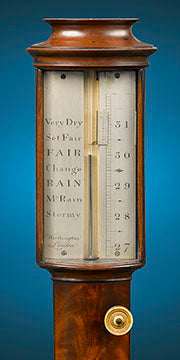If only we could see into the future...When it comes to the weather, the barometer may be the closest thing we have to a crystal ball.

English Stick Barometer by Worthington of London
This remarkable device is used to measure atmospheric pressure changes as an indicator of changes in the weather. Today, weather stations around the world use stick barometers for accurate forecasting, and for those of us who love nostalgia, an antique barometer provides the same information in a masterfully crafted case.
Evangelista Torricelli is credited with inventing the first barometer in 1643. A physician and mathematician, Torricelli had moved to Florence to assist Galileo. While performing various experiments concerning the nature of air and vacuums, he uncovered the basic principle of the barometer design. Furthermore, he used mercury in his vacuum experiments and discovered that the height of the mercury, which changed from day to day, was related to changes in atmospheric pressure. Soon, his principles were accepted by scientists throughout the continent.
Interestingly, stick barometers were not originally used for meteorological observations but for measuring heights and to use in air pump/vacuum experiments. Weather forecasting became a secondary feature once it was realized that a connection existed between the alterations in the weight of the air and alterations in the weather.
So, why is mercury used in a barometer to measure the weight of the air? Simply put, mercury is the heaviest liquid and requires the shortest column to achieve an accurate reading. While a mercury barometer needs only a three-foot glass tube, it would take a column of over 30 feet to measure the air pressure using water. But not all barometers are mercury barometers.

Close up of English Stick Barometer by Worthington of London. Owning a barometer in the early Georgian period was considered a basic necessity and even households of the most modest means were often in possession of some manner of the instrument.
In 1843, 200 years after the first barometer was created, French scientist Lucien Vidie created the first version of the now-common (and much more portable, although less accurate) aneroid barometer, aneroid meaning without liquid. Aneroid barometers are widely used today in various industries, including aviation, marine, and outdoor activities.
Barometers appeared in the retail shops of clockmakers, instrument makers, cabinet makers and opticians around 1680. The industry flourished, especially in England, a country renowned for making the best clocks, watches, locks, thermometers, barometers, and inclement weather. The weather-forecasting instrument became a must-have for wealthy households, creating a statement not only of prestige but fashion too. The earliest barometers were of the simplest form, for mercury was incredibly expensive and a costly case would only add to the already high price.
Around 1690, decorative barometers appeared, including the wheel barometer, beautifully encased in the choicest woods such as walnut, ebony, and olive. Other popular types of barometers included the straight-tube type and the angle barometer design. Designs rapidly advanced at the turn of the seventeenth century as the demand for domestic barometers began to increase. The mercurial barometer became widely accepted as the domestic weather glass, replacing the common water weather glass. Cases began to reflect the prevailing decorative arts fashions, the most popular of which was the banjo barometer. This prevalent design most likely originated in France during the late 18th century, quickly spreading to the workshops of talented English manufacturers at the turn of the 19th century.
As Britain’s national wealth increased and its population doubled, the 19th century ushered in an expanding middle class who began furnishing their homes more comfortably. This resulted in a rise in furniture production as well as home accessories, including the barometer. Major retailers of this weather instrument were opticians and glass retailers, while scientific instrument makers produced barometers for meteorological and scientific work. Two of the most well-known barometer specialists of the period included Balthazar Knie (fl. 1743-1817) and Alexander Adie (1774-1858).

Empire Revival Barometer and Thermometer. Designed in the Empire taste, the barometer and thermometer are mounted in a beautiful lyre-form mahogany frame accentuated by exquisitely detailed ormolu mounts.
Since the early 18th century, the barometer has been an integral part of British domestic life, utilized as an essential business tool and family decision maker, for weather is always an important factor when making family decisions. When reading a barometer, remember the following: falling barometric pressure denotes stormy or rainy weather, rising pressure indicates a return of fair weather and steady barometric pressure means there will most likely be no significant change. Since the late seventeenth century, barometers were marked with the following (or similar) indications, which remain accurate today: Very Dry, Settled Fair, Fair, Changeable, Rain, Much Rain, or Stormy (or a variation of these).
For more than 300 years, beautifully designed barometers have graced the walls of palaces, estates, country manors and the like. Since its inception in 1643, information gained about the study of air pressure and vacuums from barometers played an integral role in the eventual development of the steam engine, one of the primary inventions that signaled the beginning of the Industrial Revolution. Antique barometers, which come in a myriad of creative, beautifully crafted cases, are useful tools for indicating future weather patterns without sacrificing personal taste. Not to mention a handsome addition to any home or office when it comes to decorating with antiques.
Browse our collection of antiques to find an item or two that speaks to you and your style.






